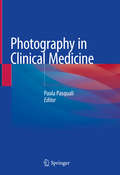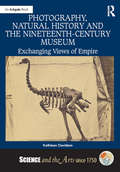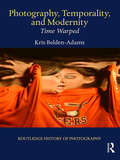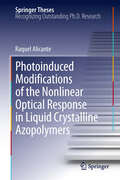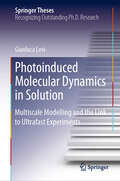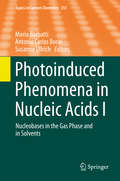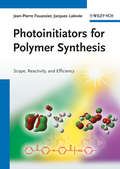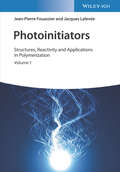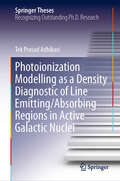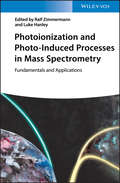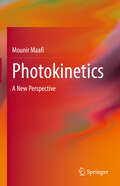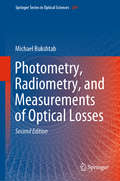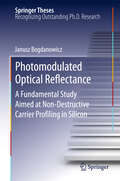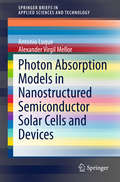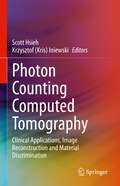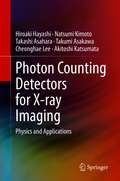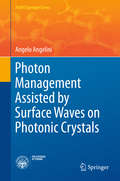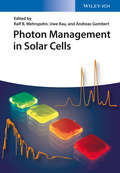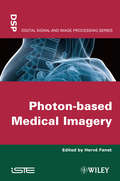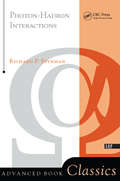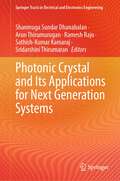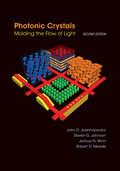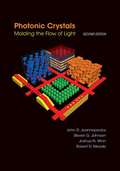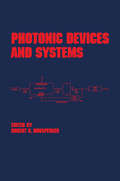- Table View
- List View
Photography in Clinical Medicine
by Paola PasqualiThis book explains how medical photography is part of the workflow in many specialties: it is needed for registries, to preserve information, for follow up, second opinion and teaching, among others. The book gathers information on this field, providing valuable practical tips for those that have never used photography for medical uses as well as those who use it regularly. Covering specialities ranging from dermatology, plastic surgery, dentistry, ophthalmology and endoscopy to forensic medicine, specimen photography and veterinary medicine, it highlights standardization for each procedure and relevance to ethical, patients’ perception of medical photography, cybersecurity and legal aspects. The book also presents practical sections explaining how to organize a photographic file, coding, reimbursement, compliance, use of social media and preservation as well as in depth concepts on sharp focus on blurred vision. This volume will appeal to all clinicians and practitioners interested in acquiring a high level of technical skill in medical photography.
Photography, Natural History and the Nineteenth-Century Museum: Exchanging Views of Empire (Science and the Arts since 1750)
by Kathleen DavidsonThe Victorian era heralded an age of transformation in which momentous changes in the field of natural history coincided with the rise of new visual technologies. Concurrently, different parts of the British Empire began to more actively claim their right to being acknowledged as indispensable contributors to knowledge and the progress of empire. This book addresses the complex relationship between natural history and photography from the 1850s to the 1880s in Britain and its colonies: Australia, New Zealand and, to a lesser extent, India. Coinciding with the rise of the modern museum, photography’s arrival was timely, and it rapidly became an essential technology for recording and publicising rare objects and valuable collections. Also during this period, the medium assumed a more significant role in the professional practices and reputations of naturalists than has been previously recognized, and it figured increasingly within the expanding specialized networks that were central to the production and dissemination of new knowledge. In an interrogation that ranges from the first forays into museum photography and early attempts to document collecting expeditions to the importance of traditional and photographic portraiture for the recognition of scientific discoveries, this book not only recasts the parameters of what we actually identify as natural history photography in the Victorian era but also how we understand the very structure of empire in relation to this genre at that time.
Photography, Temporality, and Modernity: Time Warped (Routledge History of Photography)
by Kris Belden-AdamsThis book examines the photography’s unique capacity to represent time with a degree of elasticity and abstraction. Part object-study, part cultural/philosophical history, it examines the medium’s ability to capture and sometimes "defy" time, while also traveling as objects across time-and-space nexuses. The book features studies of understudied, widespread, practices: studio portraiture, motion studies, panoramas, racing photo finishes, composite college class pictures, planetary photography, digital montages, and extended-exposure images. A closer look at these images and their unique cultural/historical contexts reveals photography to be a unique medium for expressing changing perceptions of time, and the anxiety its passage provokes.
Photoinduced Modifications of the Nonlinear Optical Response in Liquid Crystalline Azopolymers
by Raquel AlicanteNonlinear optical (NLO) phenomena such as frequency conversion have played a key role in the development of photonic technologies. This thesis reports a detailed study of the molecular response of a large variety of push-pull organic compounds using the Second Harmonic Generation technique, which will serve as a starting point for the investigation at the macroscopic scale of azobenzene-based liquid crystalline polymeric films and their blends with highly efficient NLO chromophores. These materials are designed with the aim of exploiting their photoadressability in order to tailor their nonlinear behaviour. The magnitude and symmetry of their NL response was successfully controlled via light irradiation and thermal treatments. Moreover, as a specific application, the recording of efficient NLO gratings was achieved.
Photoinduced Molecular Dynamics in Solution: Multiscale Modelling and the Link to Ultrafast Experiments (Springer Theses)
by Gianluca LeviThis book explores novel computational strategies for simulating excess energy dissipation alongside transient structural changes in photoexcited molecules, and accompanying solvent rearrangements. It also demonstrates in detail the synergy between theoretical modelling and ultrafast experiments in unravelling various aspects of the reaction dynamics of solvated photocatalytic metal complexes. Transition metal complexes play an important role as photocatalysts in solar energy conversion, and the rational design of metal-based photocatalytic systems with improved efficiency hinges on the fundamental understanding of the mechanisms behind light-induced chemical reactions in solution. Theory and atomistic modelling hold the key to uncovering these ultrafast processes. Linking atomistic simulations and modern X-ray scattering experiments with femtosecond time resolution, the book highlights previously unexplored dynamical changes in molecules, and discusses the development of theoretical and computational frameworks capable of interpreting the underlying ultrafast phenomena.
Photoinduced Phenomena in Nucleic Acids II
by Mario Barbatti Antonio Carlos Borin Susanne UllrichThe series Topics in Current Chemistry presents critical reviews of the present and future trends in modern chemical research. The scope of coverage is all areas of chemical science including the interfaces with related disciplines such as biology, medicine and materials science. The goal of each thematic volume is to give the non-specialist reader, whether in academia or industry, a comprehensive insight into an area where new research is emerging which is of interest to a larger scientific audience. Each review within the volume critically surveys one aspect of that topic and places it within the context of the volume as a whole. The most significant developments of the last 5 to 10 years are presented using selected examples to illustrate the principles discussed. The coverage is not intended to be an exhaustive summary of the field or include large quantities of data, but should rather be conceptual, concentrating on the methodological thinking that will allow the non-specialist reader to understand the information presented. Contributions also offer an outlook on potential future developments in the field. Review articles for the individual volumes are invited by the volume editors. Readership: research chemists at universities or in industry, graduate students.
Photoinitiators for Polymer Synthesis
by Jacques Lalevée J. P. FouassierPhotoinitiating systems for polymerization reactions are largely encountered in a variety of traditional and high-tech sectors, such as radiation curing, (laser) imaging, (micro)electronics, optics, and medicine.This book extensively covers radical and nonradical photoinitiating systems and is divided into four parts:* Basic principles in photopolymerization reactions* Radical photoinitiating systems* Nonradical photoinitiating systems* Reactivity of the photoinitiating systemThe four parts present the basic concepts of photopolymerization reactions, review all of the available photoinitiating systems and deliver athorough description of the encountered mechanisms. A large amount of experimental and theoretical data has been collected herein. Thisbook allows the reader to gain a clear understanding by providing a general discussion of the photochemistry and chemistry involved.The most recent and exciting developments, as well as the promising prospects for new applications, are outlined.
Photoinitiators: Structures, Reactivity and Applications in Polymerization
by Jacques Lalevée Jean-Pierre FouassierA comprehensive text that covers everything from the processes and mechanisms to the reactions and industrial applications of photoinitiators Photoinitiators offers a wide-ranging overview of existing photoinitiators and photoinitiating systems and their uses in ever-growing green technologies. The authors—noted experts on the topic—provide a concise review of the backgrounds in photopolymerization and photochemistry, explain the available structures, and examine excited state properties, involved mechanisms, and structure, reactivity, and efficiency relationships. The text also contains information on the latest developments and trends in the design of novel tailor-made systems. The book explores the role of current systems in existing and emerging processes and applications. Comprehensive in scope, it covers polymerization of thick samples and in-shadow areas, polymerization under LEDs, NIR light induced thermal polymerization, photoinitiators for novel specific and improved properties, and much more. Written by an experienced and internationally renowned team of authors, this important book: Provides detailed information about excited state processes, mechanisms, and design of efficient photoinitiator systems Discusses the performance of photoinitiators of polymerization by numerous examples of reactions and application Includes information on industrial applications Presents a review of current developments and challenges Offers an introduction to the background information necessary to understand the field Discusses the role played by photoinitiators in a variety of different polymerization reactions Written for polymer chemists, photochemists, and materials scientists, Photoinitiators will also earn a place on the bookshelves of photochemists seeking an authoritative, one-stop guide to the processes, mechanisms, and industrial applications of photoinitiators.
Photoionization Modelling as a Density Diagnostic of Line Emitting/Absorbing Regions in Active Galactic Nuclei (Springer Theses)
by Tek Prasad AdhikariThis book presents timely work on the nature of the physical processes underpinning two of the basic characteristics of the gas structure in the innermost region of Active Galactic Nuclei (AGN): ionized outflows and emission line regions. In addition, it describes physics-based methods for estimating the density of the astrophysical plasma surrounding AGN. All numerical computations of the photoionized gas employ the most advanced codes available (CLOUDY and TITAN). Calculations of the radiative transfer are based on the assumption of thermal and ionization equilibrium. Promising preliminary examples of comparison with current observations are included for several individual AGN. All of them suggest that the absorbing/emitting gas should have a density on the order of 1012 cm-3. Future observations will provide more objects to verify these results, and will allow us to put constraints on the launch radius of ionized outflows and therefore on the mass loading and kinetic energy outflow rates. These rates, in turn, are crucial to estimating whether the outflows have a significant feedback impact on star formation and metal enrichment in the interstellar medium of the host galaxy. In closing, the book discusses a representative example of applying powerful photoionization techniques to explain the complex physics of the AGN environment.
Photoionization and Photo-Induced Processes in Mass Spectrometry: Fundamentals and Applications
by Ralf ZimmermannProvides comprehensive coverage of laser-induced ionization processes for mass spectrometry analysis Drawing on the expertise of the leading academic and industrial research groups involved in the development of photoionization methods for mass spectrometry, this reference for analytical scientists covers both the theory and current applications of photo-induced ionization processes. It places widely used techniques such as MALDI side by side with more specialist approaches such as REMPI and RIMS, and discusses leading edge developments in ultrashort laser pulse desorption, to give readers a complete picture of the state of the technology. Photoionization and Photo-Induced Processes in Mass Spectrometry: Fundamentals and Applications starts with a complete overview of the fundamentals of the technique, covering the basics of the gas phase ionization as well as those of laser desorption and ablation, pulse photoionization, and single particle ionization. Numerous application examples from different analytical fields are described that showcase the power and the wide scope of photo ionization in mass spectrometry. -The first general reference book on photoionization techniques for mass spectrometry -Examines technologies and applications of gas phase resonance-enhanced multiphoton ionization mass spectrometry (REMPI-MS) and gas phase resonance ionization mass spectrometry (RIMS) -Provides complete coverage of popular techniques like MALDI -Discusses the current and potential applications of each technology, focusing on process and environmental analysis Photoionization and Photo-Induced Processes in Mass Spectrometry: Fundamentals and Applications is an excellent book for spectroscopists, analytical chemists, photochemists, physical chemists, and laser specialists.
Photokinetics: A New Perspective
by Mounir MaafiThis monograph explores photokinetics, the study of reaction kinetics under light exposure, addressing its longstanding underdevelopment compared to thermal reaction kinetics. It systematically reviews fundamental concepts, introduces new methods and equations to quantify and predict photochemical and photothermal reaction rates, and provides a standardized framework for laboratory investigations. Covering both monochromatic and polychromatic light effects, the book presents a paradigm shift in the field, making it a valuable reference for students, researchers, and industry professionals. It lays the foundation for the advancement of photokinetics, bridging critical knowledge gaps and setting the stage for future developments. This volume serves as a valuable resource for students, researchers, and academics working with photoreactive systems.
Photomechanical Materials, Composites, and Systems: Wireless Transduction of Light into Work
by Timothy J. WhiteAn exhaustive review of the history, current state, and future opportunities for harnessing light to accomplish useful work in materials, this book describes the chemistry, physics, and mechanics of light-controlled systems.• Describes photomechanical materials and mechanisms, along with key applications• Exceptional collection of leading authors, internationally recognized for their work in this growing area• Covers the full scope of photomechanical materials: polymers, crystals, ceramics, and nanocomposites• Deals with an interdisciplinary coupling of mechanics, materials, chemistry, and physics• Emphasizes application opportunities in creating adaptive surface features, shape memory devices, and actuators; while assessing future prospects for utility in optics and photonics and soft robotics
Photometry, Radiometry, and Measurements of Optical Losses (Springer Series in Optical Sciences #163)
by Michael BukshtabThe revised 2nd edition of this practical book provides an expanded treatment and comparison of techniques used in advanced optical measurements, guiding its reader from fundamental radiometric and photometric concepts to the state-of-the-art in highly sensitive measurements of optical losses and in spectroscopic detection using coherent laser light and spontaneous radiation. The book describes and compares a broad array of high-sensitivity methods and techniques – from interferometric and/or calorimetric, acousto-optic and resonator or polarization to wavelength- and frequency-modulation, phase-shift and decay time studies, and direct-loss measurements for free-space, fiber- or waveguide-based systems and devices. <P><P> Updated throughout, the new edition describes novel trends in spectral interferometry, frequency-comb and laser-excitation spectroscopy, reflected in the developments of Raman, Brillouin and FTIR (Fourier Transform Infra-Red) techniques for biomedical research, biotech sensing and detection. It also covers broad practical implementations of time- and frequency-domain terahertz spectroscopy measurements. <P><P> This book reviews the physical concepts of radiation transfer, providing a quantitative foundation for the means of measurements of optical losses, which affect propagation and distribution of light waves in various media and in diverse optical systems and components. It focuses on the application of optical methods and procedures for the evaluation of transparent, reflecting, scattering, absorbing, and aggregated objects, and for determining the power and energy parameters of radiation and color properties of light. This updated new edition will serve as an up-to-date reference source and practical guide for those using photometric and radiometric techniques.
Photomodulated Optical Reflectance
by Janusz BogdanowiczOne of the critical issues in semiconductor technology is the precise electrical characterization of ultra-shallow junctions. Among the plethora of measurement techniques, the optical reflectance approach developed in this work is the sole concept that does not require physical contact, making it suitable for non-invasive in-line metrology. This work develops extensively all the fundamental physical models of the photomodulated optical reflectance technique and introduces novel approaches that extend its applicability from dose monitoring towards detailed carrier profile reconstruction. It represents a significant breakthrough in junction metrology with potential for industrial implementation.
Photon Absorption Models in Nanostructured Semiconductor Solar Cells and Devices
by Antonio Luque Alexander Virgil MellorThis book is intended to be used by materials and device physicists and also solar cells researchers. It models the performance characteristics of nanostructured solar cells and resolves the dynamics of transitions between several levels of these devices. An outstanding insight into the physical behaviour of these devices is provided, which complements experimental work. This therefore allows a better understanding of the results, enabling the development of new experiments and optimization of new devices. It is intended to be accessible to researchers, but also to provide engineering tools which are often only accessible to quantum physicists. Photon Absorption Models in Nanostructured Semiconductor Solar Cells and Devices is intended to provide an easy-to-handle means to calculate the light absorption in nanostructures, the final goal being the ability to model operational behaviour of nanostructured solar cells. It allows researchers to design new experiments and improve solar cell performances, and offers a means for the easy approximate calculation of the energy spectrum and photon absorption coefficients of nanostructures. This calculation is based on the effective mass model and uses a new Hamiltonian called the Empirical kp Hamiltonian, which is based on a four band kp model.
Photon Counting Computed Tomography: Clinical Applications, Image Reconstruction and Material Discrimination
by Krzysztof Kris Iniewski Scott HsiehThis book will provide readers with a good overview of some of most recent advances in the field of Photon Counting CT technology for X-ray medical imaging, especially as it pertains to new detectors. There will be a good mixture of general chapters in both technology and applications in CT medical imaging. The book will have an in-depth review of the research topics from world-leading specialists in the field. The conversion of the X-ray signal into analogue/digital value will be covered in some chapters. The authors also provide a review of CMOS chips for X-ray image sensors, methods of material discrimination and image reconstruction techniques.Covers a broad range of topics, including an introduction to novel spectral Computed Tomography;Includes in-depth analysis on how to optimize X-ray detection;Discusses analysis of electronics for X-ray detection.
Photon Counting Detectors for X-ray Imaging: Physics and Applications
by Hiroaki Hayashi Natsumi Kimoto Takashi Asahara Takumi Asakawa Cheonghae Lee Akitoshi KatsumataThis book first provides readers with an introduction to the underlying physics and state-of-the-art application of photon counting detectors for X-ray imaging. The authors explain that a photon-counting imaging detector can realize quantitative analysis because the detector can derive X-ray attenuation information based on the analysis of intensity changes of individual X-ray. To realize this analysis, it is important to consider the physics of an object and detector material. In this book, the authors introduce a novel analytical procedure to create quantitative X-ray images for medical diagnosis.
Photon Management Assisted by Surface Waves on Photonic Crystals
by Angelo AngeliniThis book illustrates original pathways to manipulate light at the nanoscale by means of surface electromagnetic waves (here, Bloch surface waves, BSWs) on planar dielectric multilayers, also known as one-dimensional photonic crystals. This approach is particularly valuable as it represents an effective alternative to the widely exploited surface plasmon paradigm. After a brief overview on the fundamentals of BSWs, several significant applications of BSW-sustaining structures are described. Particular consideration is given to the propagation, guiding, and diffraction of BSW-coupled radiation. Further, the interaction of organic emitters with BSWs on planar and corrugated multilayers is investigated, including fluorescence beaming in free space. To provide greater insight into sensing applications, an illustrative example of fluorescent microarray-based detection is presented. The book is intended for scientists and researchers working on photon management opportunities in fields such as biosensing, optical circuitry, and lighting.
Photon Management in Solar Cells
by Uwe Rau Ralf B. Wehrspohn Andreas GombertWritten by renowned experts in the field of photon management in solar cells, this one-stop reference gives an introduction to the physics of light management in solar cells, and discusses the different concepts and methods of applying photon management. The authors cover the physics, principles, concepts, technologies, and methods used, explaining how to increase the efficiency of solar cells by splitting or modifying the solar spectrum before they absorb the sunlight. In so doing, they present novel concepts and materials allowing for the cheaper, more flexible manufacture of solar cells and systems. For educational purposes, the authors have split the reasons for photon management into spatial and spectral light management. Bridging the gap between the photonics and the photovoltaics communities, this is an invaluable reference for materials scientists, physicists in industry, experimental physicists, lecturers in physics, Ph.D. students in physics and material sciences, engineers in power technology, applied and surface physicists.
Photon-based Medical Imagery
by Hervé FanetThis book describes the different principles and equipments used in medical imaging. Importance of medical imaging for diagnostic is strongly increasing and it is now necessary to have a good knowledge of the different physical possible principles. Researchers, clinicians, engineers and professionals in this area, along with postgraduate students in the signal and image processing field, will find this book of great interest.
Photon-hadron Interactions
by Richard P. FeynmanIn these classic lectures, Feynman analyses the theoretical questions related to electron and photon interactions at high energies. These lectures are based on a special topics course taught by Feynman at Caltech in 1971 and 1972. The material is dealt with on an advanced level and includes discussions of vector meson dominance and deep inelastic scattering. The possible consequences of the parton model are also analyzed.
Photonic Crystal and Its Applications for Next Generation Systems (Springer Tracts in Electrical and Electronics Engineering)
by Ramesh Raju Sathish-Kumar Kamaraj Arun Thirumurugan Shanmuga Sundar Dhanabalan Sridarshini ThirumaranThis book covers the advanced fabrication techniques, challenges, and applications of photonic crystals for next-generation systems in various applications such as high-speed networks, photonic integrated circuits, health care, sensors, energy, and environmental. This book highlights the literature and works put forward by various scientists, researchers, and academicians in photonic crystals and their real-time applications. The content of the book appeals to readers such as students, researchers, and industrial engineers who are working in the design and development of photonics-based concepts, components, and devices for various applications.
Photonic Crystals
by Robert D. Meade John D. Joannopoulos Steven G. Johnson Joshua N. WinnSince it was first published in 1995, Photonic Crystals has remained the definitive text for both undergraduates and researchers on photonic band-gap materials and their use in controlling the propagation of light. This newly expanded and revised edition covers the latest developments in the field, providing the most up-to-date, concise, and comprehensive book available on these novel materials and their applications. Starting from Maxwell's equations and Fourier analysis, the authors develop the theoretical tools of photonics using principles of linear algebra and symmetry, emphasizing analogies with traditional solid-state physics and quantum theory. They then investigate the unique phenomena that take place within photonic crystals at defect sites and surfaces, from one to three dimensions. This new edition includes entirely new chapters describing important hybrid structures that use band gaps or periodicity only in some directions: periodic waveguides, photonic-crystal slabs, and photonic-crystal fibers. The authors demonstrate how the capabilities of photonic crystals to localize light can be put to work in devices such as filters and splitters. A new appendix provides an overview of computational methods for electromagnetism. Existing chapters have been considerably updated and expanded to include many new three-dimensional photonic crystals, an extensive tutorial on device design using temporal coupled-mode theory, discussions of diffraction and refraction at crystal interfaces, and more. Richly illustrated and accessibly written, Photonic Crystals is an indispensable resource for students and researchers.Extensively revised and expanded Features improved graphics throughout Includes new chapters on photonic-crystal fibers and combined index-and band-gap-guiding Provides an introduction to coupled-mode theory as a powerful tool for device design Covers many new topics, including omnidirectional reflection, anomalous refraction and diffraction, computational photonics, and much more.
Photonic Crystals: Molding the Flow of Light
by Robert D. Meade John D. Joannopoulos Steven G. Johnson Joshua N. WinnSince it was first published in 1995, Photonic Crystals has remained the definitive text for both undergraduates and researchers on photonic band-gap materials and their use in controlling the propagation of light. This newly expanded and revised edition covers the latest developments in the field, providing the most up-to-date, concise, and comprehensive book available on these novel materials and their applications. Starting from Maxwell's equations and Fourier analysis, the authors develop the theoretical tools of photonics using principles of linear algebra and symmetry, emphasizing analogies with traditional solid-state physics and quantum theory. They then investigate the unique phenomena that take place within photonic crystals at defect sites and surfaces, from one to three dimensions. This new edition includes entirely new chapters describing important hybrid structures that use band gaps or periodicity only in some directions: periodic waveguides, photonic-crystal slabs, and photonic-crystal fibers. The authors demonstrate how the capabilities of photonic crystals to localize light can be put to work in devices such as filters and splitters. A new appendix provides an overview of computational methods for electromagnetism. Existing chapters have been considerably updated and expanded to include many new three-dimensional photonic crystals, an extensive tutorial on device design using temporal coupled-mode theory, discussions of diffraction and refraction at crystal interfaces, and more. Richly illustrated and accessibly written, Photonic Crystals is an indispensable resource for students and researchers. * Extensively revised and expanded * Features improved graphics throughout * Includes new chapters on photonic-crystal fibers and combined index-and band-gap-guiding * Provides an introduction to coupled-mode theory as a powerful tool for device design * Covers many new topics, including omnidirectional reflection, anomalous refraction and diffraction, computational photonics, and much more.
Photonic Devices and Systems
by HunspergerThis work describes all the major devices used in photonic systems. It provides a thorough overview of the field of photonics, detailing practical examples of photonic technology in a wide range of applications. Photonic systems and devices are discussed with a mathematical rigor that is precise enough for design purposes yet highly readable.
